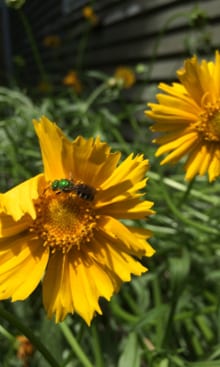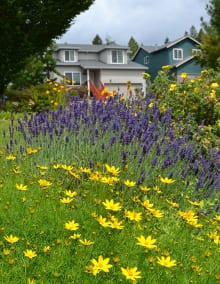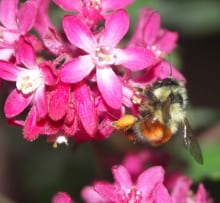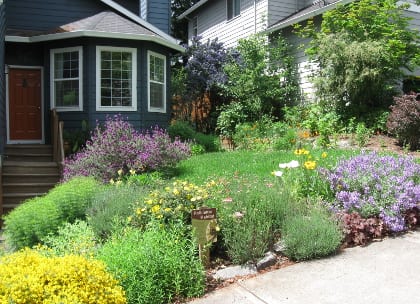by Matthew Shepherd
The National Pollinator Garden Network (NPGN) is a newly created partnership of organizations involved with pollinator conservation, wildlife gardening, and gardens. The network was initiated as part of the White House’s National Pollinator Strategy released earlier this summer. It draws together nearly two dozen nonprofits and organizations with a shared aim, to make gardens better for pollinators nationwide.

A sweat bee (Agapostemon) enjoys large-flowered coreopsis (Coreopsis grandiflora). Photo: Matthew Shepherd
The NPGN was launched by First Lady Michelle Obama in early June during an event at the White House. And with the launch came the Million Pollinator Garden Challenge: Can the nation establish a network of one million pollinator gardens within two years?
As a landscape professional, you can play a significant role in building this network, both through design and creation of new gardens and by adapting maintenance of existing gardens. The hotter-than-normal weather and drought conditions gripping various regions of North America are leading people to rethink their gardens: Are lawns sustainable in the face of water shortages and restrictions? Ripping up a brown lawn and replacing it with drought tolerant native plants may be a winning formula for pollinators and homeowners. Homeowners often look to their garden to provide another room for their house. Surrounding a patio with flowers can create a serene retreat for entertaining or relaxation while also providing habitat for butterflies and bees.

Threadleaf coreopsis (Coreopsis verticillata) and English lavender (Lavandula angustifolia) offer a pollinator feast along with large-flowered coreopsis (Coreopsis grandiflora), blanketflower (Gaillardia aristata), and a shrubby cinquefoil (Potentilla fruticosa). Photo: Matthew Shepherd
There is no rigid formula for what constitutes a pollinator garden. It doesn’t need to be big, but it should offer a mix of nectar-rich flowers and be free of insecticides. If there’s enough space, include somewhere for bees to nest and provide host plants for caterpillars to munch on. (Sometimes good gardening means holes in leaves.) The Xerces Society’s Bring Back the Pollinators campaign promotes four principles—grow flowers, provide nest sites, avoid pesticides, and share the word—that can be adapted to any location.
Fill a window box with flowers. Add planters to a deck. Create a colorful garden border. Mix flowers with the vegetables in a community garden. Enhance the grounds of a school or church. And for the challenge, what’s accepted as a garden goes much wider: city park, golf course, corporate or university campus, farm. These are all places that can be improved for pollinators, so the challenge can be accepted by anyone. The only limitation is your imagination!
To make the garden count, ask your client to go to Bring Back the Pollinators and sign the Pollinator Protection Pledge. The garden will be added to the one million. If you’ve already signed the Pledge (and some 3,500 people have), don’t worry, your garden will still count; existing gardens are being grandfathered in.
You can also find lots of information about bee-safe gardening at Bring Back the Pollinators: regional plant lists, guidance on nest sites for bees and caterpillar host plants for butterflies, advice on insecticides, even a way to purchase the best available book on pollinator conservation, “Attracting Native Pollinators.”
One million pollinator gardens. That’s the challenge. Will you pick up the gauntlet—or gardening glove—and help?
About the Author

A black-tailed bumblebee (Bombus melanopygus) on a flowering currant (Ribes sanguineum). Photo: Mace Vaughan.
Matthew Shepherd started gardening at his mother’s side and has created and maintained gardens everywhere he has lived, both around his own home and in schools and other public spaces. He has worked for the Xerces Society for over 15 years. He is currently the Communications Director but previously worked on the pollinator conservation program.


